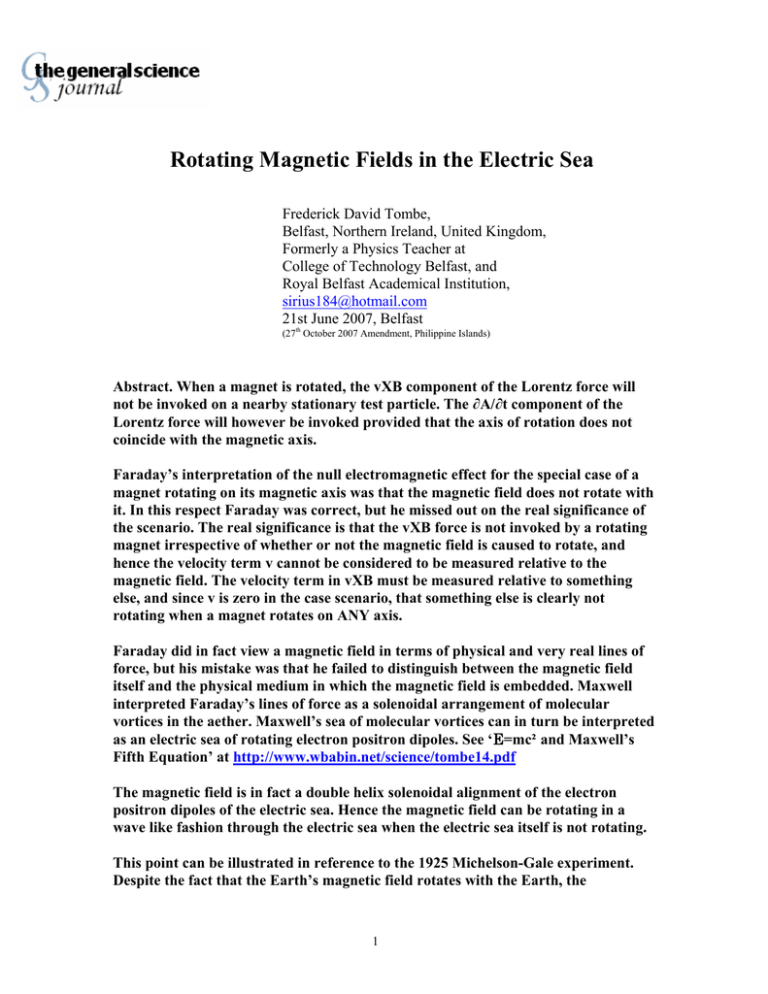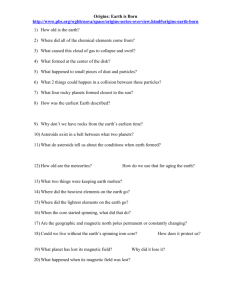Rotating Magnetic Fields in the Electric Sea
advertisement

Rotating Magnetic Fields in the Electric Sea Frederick David Tombe, Belfast, Northern Ireland, United Kingdom, Formerly a Physics Teacher at College of Technology Belfast, and Royal Belfast Academical Institution, sirius184@hotmail.com 21st June 2007, Belfast (27th October 2007 Amendment, Philippine Islands) Abstract. When a magnet is rotated, the vXB component of the Lorentz force will not be invoked on a nearby stationary test particle. The ∂A/∂t component of the Lorentz force will however be invoked provided that the axis of rotation does not coincide with the magnetic axis. Faraday’s interpretation of the null electromagnetic effect for the special case of a magnet rotating on its magnetic axis was that the magnetic field does not rotate with it. In this respect Faraday was correct, but he missed out on the real significance of the scenario. The real significance is that the vXB force is not invoked by a rotating magnet irrespective of whether or not the magnetic field is caused to rotate, and hence the velocity term v cannot be considered to be measured relative to the magnetic field. The velocity term in vXB must be measured relative to something else, and since v is zero in the case scenario, that something else is clearly not rotating when a magnet rotates on ANY axis. Faraday did in fact view a magnetic field in terms of physical and very real lines of force, but his mistake was that he failed to distinguish between the magnetic field itself and the physical medium in which the magnetic field is embedded. Maxwell interpreted Faraday’s lines of force as a solenoidal arrangement of molecular vortices in the aether. Maxwell’s sea of molecular vortices can in turn be interpreted as an electric sea of rotating electron positron dipoles. See ‘E=mc² and Maxwell’s Fifth Equation’ at http://www.wbabin.net/science/tombe14.pdf The magnetic field is in fact a double helix solenoidal alignment of the electron positron dipoles of the electric sea. Hence the magnetic field can be rotating in a wave like fashion through the electric sea when the electric sea itself is not rotating. This point can be illustrated in reference to the 1925 Michelson-Gale experiment. Despite the fact that the Earth’s magnetic field rotates with the Earth, the 1 Michelson-Gale experiment detected a relative rotation of the luminiferous medium in relation to the Earth’s diurnal motion. This would be further evidence to suggest that the electric sea does not rotate with a magnet, irrespective of the orientation of the rotation axis, and irrespective of whether or not the magnetic field is rotating. Rotational Slippage in the Electric Sea I. The Earth’s magnetic field does rotate with the Earth. We can see this clearly due to the fact that the Earth’s magnetic axis is not aligned exactly with the Earth’s rotational axis. However, the Michelson-Gale experiment of 1925 indicates to us that the medium in which electromagnetic radiation is embedded, may not be fully partaking in the Earth’s rotation, if at all. The magnetic field itself is merely a solenoidal alignment of magnetized electron positron dipoles within the electric sea. The Earth is a permanent magnet, and as it rotates it changes the alignment of the electric sea such as to give the effect that the magnetic field is rotating with the Earth. This of course does not mean that the electric sea itself has to be rotating with the Earth. The diameter of electron positron dipoles is likely to be in the order of the wavelength of gamma rays since it is gamma rays that can split these dipoles apart. It follows therefore that the dipoles of the electric sea are likely to be anything from one thousandth to one millionth the size of an average atom and as such they should have no difficulty whatsoever in passing between the spaces of atomic and molecular matter. When a magnet rotates, it would appear that the electric sea flows through the magnet just as water flows through a basket. Translational Motion and the Entrainment of the Electric Sea II. The 1887 Michelson-Morley experiment shows us that the electric sea is entrained with the Earth in its translational motion around the Sun. Gravity would naturally bond the electric sea to the Earth, and the bonded electric 2 sea would naturally extend to the shear line at the bonded electric sea of the next nearest planet or object. Linear polarization of the electric sea due to the gravitational field lines of the two planets will ensure that all shear lines are in the axial plane of the gravitational field lines. See ‘Gravity Reversal and Atomic Bonding’ at, http://www.wbabin.net/science/tombe6.pdf Hence the shear lines will be cushioned with centrifugal pressure and the planets will frictionlessly glide over each other like hovercrafts. Relative translational motion between planets must be either radial or tangential. In the case of radial motion, the electric sea between the two planets will flow out sideways along the gravitational field lines when the planets are coming together, in order to make room for the planets. The electric sea will flow inwards along the gravitational field lines when the planets are moving apart, in order to fill the gap vacated by the planets. 3





